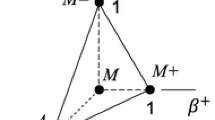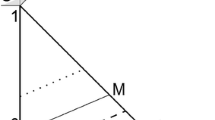Abstract
This paper presents a multi-dimensional thermomechanical constitutive model for shape memory alloys (SMAs). This constitutive relation is based upon a combination of both micromechanics and macromechanics. The martensite fraction is introduced as a variable in this model to reflect the martensitic transformation that determines the unique characteristics of shape memory alloys. This constitutive relation can be used to study the complex behavior associated with 2-D and 3-D SMA structures. A simple example using this constitutive model is also presented, which reveals a new and interesting phenomenon of 3-D SMA structures.
Similar content being viewed by others

References
C. Liang and C.A. Rogers, A one-dimensional thermomechanical constitutive relation of shape memory materials.Journal of Intelligent Material Systems and Structures 1 (1990) 207–234.
E.N. Bondaryev and C.M. Wayman, Some stress-strain-temperature relationships for shape memory alloys.Metallurgical Transactions 19A (1988).
C. Liang, The constitutive modeling of shape memory alloys, Ph.D. Dissertation, Department of Mechanical Engineering, Virginia Polytechnic Institute and State University, Blacksburg, Va., August (1990).
C. Liang and C.A. Rogers, Design of shape memory alloy actuators.Journal of Mechanical Design (in press).
C. Liang and C.A. Rogers, Design of shape memory alloy springs and their applications in vibration control.ASME Journal of Vibration and Acoustics (in press).
H. Funakubo,Shape Memory Alloys, New York: Gordon and Breach Science Publishers (1987).
E.J. Graesser, Multi-dimensional modeling of hysteretic materials including shape memory alloys. PhD Dissertation, Dept. of Mech. and Aero. Eng., State Uni. of New York at Buffalo, January (1990).
I. Müller, Pseudoelasticity in shape memory alloys-an extreme case of thermoelasticity, IMA Preprint No. 169, July (1985).
T. Kakeshita, Y. Yoshimura and K. Shimizy, Effect of hydrostatic pressure on martensitic transformations in Cu-Al-Ni shape memory alloys.Transactions of Japan Institute of Metals 29 (1988) 781–789.
J.W. Hutchinson and K.W. Neale,Finite Strain J 2 Deformation Theory. Proceeding of the IUTAM Symposium on Finite Elasticity, Lehigh University, Bethlehem, Pa., 10–15 August (1980).
C. Liang, Transient thermoelasto-plastic constitutive relations of materials, Master's Thesis, Department of Jet Propulsion, Beijing Institute of Aeronautics and Astronautics (1986).
J. Chakrabarty,Theory of Plasticity, New York: McGraw-Hill (1987).
Author information
Authors and Affiliations
Rights and permissions
About this article
Cite this article
Liang, C., Rogers, C.A. A multi-dimensional constitutive model for shape memory alloys. J Eng Math 26, 429–443 (1992). https://doi.org/10.1007/BF00042744
Received:
Accepted:
Issue Date:
DOI: https://doi.org/10.1007/BF00042744



